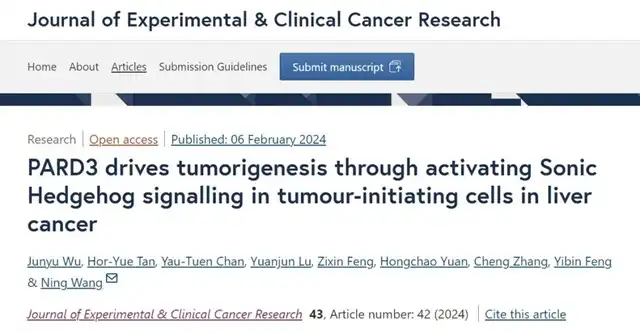Unveiling a Potential Preventive Target for Liver Cancer: The Role of PARD3
- Normal Liver Cells Found to Promote Cancer Metastasis to the Liver
- Nearly 80% Complete Remission: Breakthrough in ADC Anti-Tumor Treatment
- Vaccination Against Common Diseases May Prevent Dementia!
- New Alzheimer’s Disease (AD) Diagnosis and Staging Criteria
- Breakthrough in Alzheimer’s Disease: New Nasal Spray Halts Cognitive Decline by Targeting Toxic Protein
- Can the Tap Water at the Paris Olympics be Drunk Directly?
Unveiling a Potential Preventive Target for Liver Cancer: The Role of PARD3
- Should China be held legally responsible for the US’s $18 trillion COVID losses?
- CT Radiation Exposure Linked to Blood Cancer in Children and Adolescents
- FDA has mandated a top-level black box warning for all marketed CAR-T therapies
- Can people with high blood pressure eat peanuts?
- What is the difference between dopamine and dobutamine?
- How long can the patient live after heart stent surgery?
Unveiling a Potential Preventive Target for Liver Cancer: The Role of PARD3
Inhibiting Cancer Occurrence! Latest Study from the University of Hong Kong Reveals Potential Preventive Target for Liver Cancer.
The Par-3 Family Cell Polarity Regulator (PARD3) is a cellular protein crucial for asymmetric cell division and polarization growth.
On February 6th, researchers from the University of Hong Kong published a study titled “PARD3 drives tumorigenesis through activating Sonic Hedgehog signalling in tumour-initiating cells in liver cancer” in the journal “Journal of Experimental & Clinical Cancer Research.” This research unveils PARD3 as a potential target for preventing liver cancer by regulating the function of Tumour-Initiating Cells (TICs).

Research Background
Primary liver cancer ranks as the sixth most common cancer globally and the third deadliest cancer, with an estimated 41,210 new cases and 29,380 deaths in the United States alone in 2023.
Hepatocellular carcinoma (HCC) constitutes the primary form of liver cancer, often diagnosed at advanced stages with poor prognosis.
HCC is considered a heterogeneous disease with tumor tissues containing cancer cell populations exhibiting distinct gene expression characteristics and molecular functions.
The heterogeneity of HCC is maintained by a subset of cells with stem cell-like properties known as Tumour-Initiating Cells (TICs).
TICs sustain the heterogeneous structure of tumors through their self-renewal and differentiation capabilities, leading to treatment failure and recurrence in HCC. The molecular mechanisms underlying early hepatocarcinogenesis remain to be elucidated.
Existing evidence suggests a crucial role of TICs in hepatocarcinogenesis. Specifically, hepatic progenitor cells, as the cellular origin of carcinogenesis, undergo a series of alterations in molecular events induced by chronic liver disease, including but not limited to sustained DNA damage and increased chromosomal instability.
Consequently, hepatic progenitor cells gradually transform into TICs, further initiating tumor formation and progression.
Signaling pathways and molecules that maintain the stem cell characteristics of TICs have been a hot topic in cancer research.
The Par-3 Family Cell Polarity Regulator (PARD3) is a member of the Par polarity complex, which controls cellular polarity.
PARD3 plays a significant role in biological processes associated with spatial asymmetry, such as Asymmetric Cell Division (ACD), particularly highly conserved in TICs.
Through ACD, TICs generate a large population of tumor cells while maintaining a subpopulation of cells with stem cell characteristics.
Aberrant regulation and involvement of PARD3 in the progression of various malignant tumors have been reported. Recent studies suggest that cellular polarity mechanisms may participate in carcinogenic activities during cellular transformation.
However, the specific mechanism by which PARD3 regulates hepatocarcinogenesis remains unclear.
Research Findings
This study systematically investigated the role of PARD3 in hepatocarcinogenesis. Researchers found upregulation of PARD3 during the tumorigenesis stage in a spontaneous HCC mouse model.
The essential role of PARD3 in diet-induced hepatocarcinogenesis was confirmed through loss-of-function and gain-of-function studies.
Overexpression of PARD3 resulted in the enrichment of CD133+ TICs in an orthotopic HCC model. Mechanistically, PARD3 maintains the stemness of CD133+ cells by activating SHH signaling.
The study demonstrates PARD3 as a potential target for inhibiting liver cancer occurrence.
Research Conclusion
In summary, this study reveals PARD3 as a potential preventive target for liver cancer by regulating the function of TICs.
Unveiling a Potential Preventive Target for Liver Cancer: The Role of PARD3
(source:internet, reference only)
Disclaimer of medicaltrend.org
Important Note: The information provided is for informational purposes only and should not be considered as medical advice.



